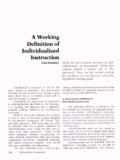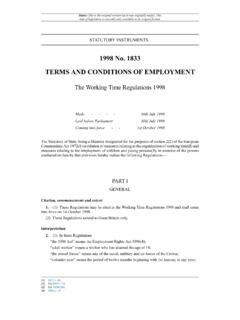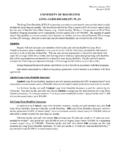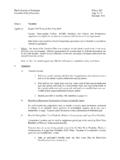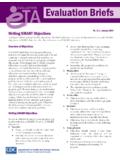Transcription of Bounding Partisan Approval Rates Under Endogenous ...
1 Bounding Partisan Approval Rates UnderEndogenous Partisanship: Why High PresidentialPartisan Approval May Not Be What It SeemsB. Pablo Montagnes , Zachary Peskowitz , and Joshua McCrain Running header: Bounding Partisan Approval Rates Assistant Professor, Department of Political Science, Emory Corresponding author, Assistant Professor, Department of Political Science, Emory PhD student, Department of Political Science, Emory The presidential Approval rate among a president s co-partisans has receiveda great deal of attention and is an important quantity for understanding accountability ofthe executive branch. We show that the reported composition of the president s party isendogenous to presidential popularity, with the party growing and becoming more ideologi-cally moderate as presidential popularity increases.
2 As a result, observed Partisan approvalrates may be biased due to compositional change in respondents who self-identify with thepresident s party. We derive bounds on the compositionally-corrected Partisan Approval rateunder a theoretically-motivated monotonicity condition. We examine how the bounds haveevolved during the Obama and Trump presidencies. The proportion of survey respondentswho identify with the Republican party has decreased rapidly from the pre-election bench-mark during the Trump presidency and, as a result, the lower bound on Trump s partisanapproval rate is much lower than at a comparable point in the Obama : Public opinion, presidential Approval , Manski boundsSupplementary material for this article is available in the Online Appendix.
3 Replicationfiles are available in the JOP Data Archive on Dataverse ( ).In this short paper, we examine how compositional changes in public opinion polls a ectestimation of the presidential Approval rate among a president s co-partisans and employManski-style (2007) bounds to correct for these compositional changes. We document thatthe composition of self-reported partisans changes in response to the president s a result, observed Partisan Approval Rates may be biased due to changes in the compo-sition of survey respondents who self-identify with the president s party. We show that theproportion of the president s co-partisans in a survey sample relative to a benchmark level isan essential (and typically ignored) component in Bounding the Partisan Approval rate.
4 Byaccounting for changes in the proportion of president co-partisans in a survey sample relativeto an electorally-important benchmark level, we demonstrate that Partisan Approval may bemeaningfully lower than observed when fewer respondents report presidential co-partisanshipor higher than observed when more respondents report presidential Partisan presidential Approval rate has received a great deal of popular attentionrecently with many observers of American politics commenting on the high Approval ratethat President Trump enjoys among self-identified Republicans even while his aggregate ap-proval rate is low by historic standards (Shepard 2017). Commentators have also noted thatthe Partisan Approval rate has implications for governance (Dropp and Nyhan 2017).
5 Highpresidential Partisan Approval Rates may insulate the president from electoral and legislativeaccountability. Because committee chairs set the ground rules for investigations into theexecutive branch (Kriner and Schickler 2014), the presidential Partisan Approval rate is espe-cially important Under unified government when the president s party holds majorities in theHouse and Senate. Committee chairs may condition their willingness to hold the executivebranch accountable for its actions on the president s Approval rate among legislators par-tisan electorate. More broadly, co-partisans of the president seek to represent the views ofpartisan constituents either due to electoral or normative concerns regarding representationand these e orts have implications for the success or failure of a president s legislative agenda(Canes-Wrone and De Marchi 2002).
6 1In cross-sectional surveys, estimating outcomes in the sample of respondents with a par-ticular self-reported characteristic can result in a misleading estimate when self-reportedcharacteristics are Endogenous to external endogeneity may be the re-sult of respondents either declining to complete the survey when they are unsatisfied with thepresident s performance (Gelman et al. 2016; Hartman 2018) or changing their self-reportedpartisanship in response to their assessment of the president s performance. These possibil-ities are particularly important in the context of the presidential Partisan Approval rate. InOnline Appendix B, we provide evidence that the probability that an individual respondentidentifies with the president s party increases with presidential Approval , but that the prob-ability an individual identifies with the president s ideology is unresponsive to presidentialapproval.
7 As we demonstrate, when presidents are losing support, the naive Partisan ap-proval rate can overestimate the Approval rate among presidential co-partisans because someprior weak partisans no longer identify with the president s party. Similarly, when presi-dential Approval is high non-partisans probability of identifying with the president s partyincreases so the rate of non-partisans Approval may be show how the observed Partisan Approval rate can mislead when the sample com-position changes over time and we construct Manski-style bounds for the compositionally-corrected Partisan Approval rate. We show that Under a theoretically-motivated monotonicity1 Polls such as the RAND American Life Panel (Gutsche et al. 2014) employ high-frequencypanels that allow researchers to examine how survey responses change among the same classof individuals over time.
8 While these panels allow researchers to correct for compositionalchange by examining the outcome of interest for the same individuals over time, we focus onbounding outcomes Under compositional change with cross-sectional polls, such as Gallup spresidential Approval poll, because of their widespread use and the vast amount of popularattention that they receive. Moreover, even panel surveys are subject to attrition and non-response bias that may necessitate compositional correction and in some settings, such ashistorical studies, panels may not , the true compositionally-corrected Partisan Approval rate must lie within easily-calculable bounds. The bounds crucially depend on the proportion of survey respondents whoidentify with the president s party relative to a benchmark proportion.
9 The upper bound iscalculated by assuming that all missing ( ) partisans approve ( )of the president while the lower bound assumes that the missing ( ) partisansdisapprove ( ) of the president. These results emphasize the importance ofaccounting for the proportion of respondents in the president s party when interpreting ob-served Partisan Approval Rates . We conclude by examining how the bounds have evolvedover Obama and Trump presidencies. The proportion of survey respondents who identifywith the Republican party has decreased rapidly from the pre-election benchmark duringthe Trump presidency and, as a result, the lower bound on Trump s Partisan Approval rateis much lower than at a comparable point in the Obama make a methodological contribution to the study of compositional change in pub-lic opinion polls and has important implications for empirical studies that employ observedpartisan Approval Rates as the dependent variable.
10 Gelman et al. (2016) correct for en-dogenous survey response Rates by using multi-level regression with poststratification wherethe poststratification is performed with information on respondents partisanship and po-litical characteristics, in addition to standard demographic variables. Our approach is acomplementary method to account for changes in the composition of a survey, but insteadof point identifying the compositionally-corrected outcome using an ignorability assumptionon selection in the survey we derive bounds on this quantity Under theoretically-motivatedmonotonicity work in political science has employed Manski (2007) bounds for the purpose ofset identifying a quantity of interest. Ashworth et al. (2008) bound the attributable risk ofsuicide terrorism due to military occupation in the presence of selection on the dependentvariable.

